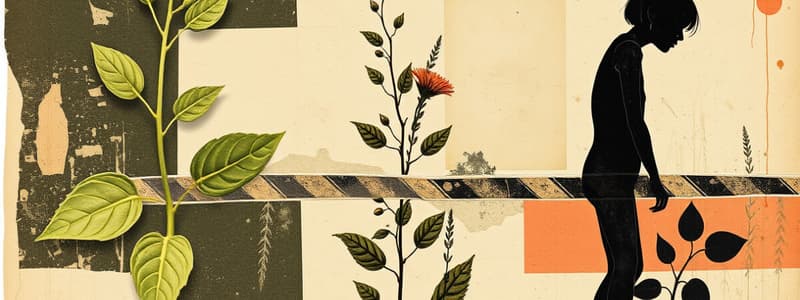Podcast
Questions and Answers
Asexual reproduction involves a single parent plant, resulting in offspring that are genetically ______.
Asexual reproduction involves a single parent plant, resulting in offspring that are genetically ______.
identical
In asexual reproduction, methods like binary fission and ______ involve the development of new individuals from an outgrowth of the parent.
In asexual reproduction, methods like binary fission and ______ involve the development of new individuals from an outgrowth of the parent.
budding
Sexual reproduction involves two parent plants and combines genetic material, leading to genetic ______.
Sexual reproduction involves two parent plants and combines genetic material, leading to genetic ______.
diversity
Pollination is the transfer of pollen from male ______ to female stigma.
Pollination is the transfer of pollen from male ______ to female stigma.
During fertilization, the male gamete (sperm) fuses with the female gamete (blank).
During fertilization, the male gamete (sperm) fuses with the female gamete (blank).
Wind dispersal involves lightweight seeds that are ______ by the wind.
Wind dispersal involves lightweight seeds that are ______ by the wind.
In water dispersal, seeds can float and are moved by ______.
In water dispersal, seeds can float and are moved by ______.
The seedling stage is where the young plant develops roots, stems, and ______.
The seedling stage is where the young plant develops roots, stems, and ______.
The ovary of the flower develops into ______ after fertilization.
The ovary of the flower develops into ______ after fertilization.
Self-dispersal occurs when seeds are ______ from the parent plant.
Self-dispersal occurs when seeds are ______ from the parent plant.
Flashcards are hidden until you start studying
Study Notes
Plant Reproduction
Types of Reproduction
-
Asexual Reproduction
- Involves a single parent plant.
- Offspring are genetically identical (clones).
- Methods include:
- Binary Fission: Division into two identical cells (common in simple plants).
- Budding: New individuals develop from an outgrowth of the parent.
- Vegetative Propagation: Use of structures like rhizomes, tubers, or runners (e.g., strawberries, potatoes).
- Cuttings: Pieces of the parent plant can develop into new plants.
-
Sexual Reproduction
- Involves two parent plants.
- Combines genetic material, leading to genetic diversity.
- Key processes include:
- Pollination: Transfer of pollen from male anthers to female stigma.
- Can be biotic (insects, animals) or abiotic (wind, water).
- Fertilization: Union of male gamete (sperm) and female gamete (egg).
- Seed Development: Fertilized ovule develops into a seed containing an embryo.
- Fruit Formation: Ovary of the flower develops into fruit, aiding seed dispersal.
- Pollination: Transfer of pollen from male anthers to female stigma.
Structures Involved
- Flowers: Reproductive organs in angiosperms, consisting of:
- Stamens: Male reproductive structures (anther and filament).
- Pistils: Female reproductive structures (stigma, style, ovary).
- Pollinators: Organisms that facilitate pollination, such as bees, butterflies, and birds.
Seed Dispersal Mechanisms
- Wind Dispersal: Lightweight seeds are carried by the wind (e.g., dandelions).
- Water Dispersal: Seeds float and are carried by water (e.g., coconuts).
- Animal Dispersal: Seeds adhere to fur or are consumed and excreted by animals (e.g., berries).
- Self-Dispersal: Seeds are ejected from the parent plant (e.g., peas).
Life Cycle Stages
- Germination: Seed absorbs water, swells, and the embryo begins to grow.
- Seedling Stage: Young plant develops roots, stems, and leaves.
- Mature Plant: Full development, capable of reproduction.
- Senescence: Aging process leading to death; can include seed production.
Importance of Plant Reproduction
- Ensures species survival and genetic diversity.
- Contributes to ecosystem stability and resilience.
- Supports food production and agricultural practices.
Types of Reproduction
-
Asexual reproduction involves a single parent and produces genetically identical offspring known as clones.
-
Methods of asexual reproduction include:
- Binary fission: Simple division resulting in two identical cells, common in basic plant species.
- Budding: New individuals form from an outgrowth on the parent plant.
- Vegetative propagation: Involves structures like rhizomes, tubers, or runners, exemplified by strawberries and potatoes.
- Cuttings: Sections of the parent plant can grow into new plants.
-
Sexual reproduction requires two parent plants, promoting genetic diversity through the combination of genetic material.
-
Key processes include:
- Pollination: Transfer of pollen from male anthers to female stigma, occurring via biotic (insects, animals) and abiotic (wind, water) agents.
- Fertilization: Union of male gametes (sperm) and female gametes (egg).
- Seed development: Fertilized ovules develop into seeds containing embryos.
- Fruit formation: The ovary of the flower matures into fruit, aiding in seed dispersal.
Structures Involved
- Flowers serve as reproductive organs in angiosperms, comprising:
- Stamens: Male structures consisting of anthers and filaments.
- Pistils: Female structures, including stigma, style, and ovary.
- Pollinators, such as bees, butterflies, and birds, are crucial for facilitating the pollination process.
Seed Dispersal Mechanisms
- Wind dispersal allows lightweight seeds to be carried away by air currents (e.g., dandelions).
- Water dispersal enables seeds to float and get transported by water (e.g., coconuts).
- Animal dispersal occurs when seeds attach to animal fur or are ingested and later excreted (e.g., berries).
- Self-dispersal involves seeds being ejected from the parent plant (e.g., peas).
Life Cycle Stages
- Germination: Seeds absorb water, swell, and initiate embryo growth.
- Seedling stage: Young plants develop essential roots, stems, and leaves.
- Mature plant: Achieves full development and is capable of reproduction.
- Senescence: The aging phase leading to death, often accompanied by seed production.
Importance of Plant Reproduction
- Plant reproduction is vital for species survival and enhancing genetic diversity.
- It contributes to the stability and resilience of ecosystems.
- Supports agricultural practices and food production.
Studying That Suits You
Use AI to generate personalized quizzes and flashcards to suit your learning preferences.




